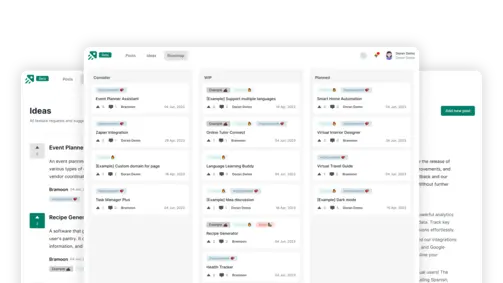What is SaaS Integration - Its Benefits and Challenges
Create changelog and product roadmap for your product
Explore nowTable of contents 6 min
In today’s rapidly evolving digital landscape, businesses constantly seek innovative solutions to enhance their operations and productivity. One such solution that has gained immense popularity is SaaS integration. Software-as-a-Service (SaaS) integration is the process of connecting and integrating multiple SaaS applications to create a smooth and seamless workflow. This article explores the concept of SaaS integration, its benefits and the challenges organizations may face while implementing it.
What Exactly is SaaS Integration?
What is SaaS integration? In the most basic terms:
SaaS integration brings together and automatically transfers data between applications.
One application may require data from another application. Without integration, you must manually input data from one application to another, which is time-consuming and prone to error.

SaaS integration is the process of connecting applications, enabling them to “talk to each other.” This process is automated by SaaS integration, whether to synchronize data in multiple locations or transfer data from one application to another.
Find out more: The Importance of customer feedback to SaaS Founders
What are the Differences between SaaS Integration, App Integration and API Integration?
Are SaaS integration and integration, app integration, and API integration the same?
In this era of SaaS, integration, SaaS integration, and app integration are interchangeable terms. SaaS has become so common that we no longer need to mention it. Integration alone is good.
API integration is a way of performing integrations. API is a collection of code-based instructions that describe how to send or receive data from an application. RESTful APIs are the most popular form of API today.
Originally, API integrations required developers to actually design how one application connects with another. In recent years, iPaaS platforms (Integration Platform as a Service) have emerged, making API integrations significantly simpler without requiring technical API knowledge.
What are the Benefits of SaaS Integration?
It Saves Time
This advantage is relatively noticeable. When your business tools can automatically transfer data, you can save time and resources by not having to do it manually. Just set up the integration, and you’re done—no more entries by hand.
Read more: How to Collect Customer Feedback Effectively
It Eliminates or Reduces Human Error
Dealing with manual data entry errors can be one of the most challenging aspects of operating a business. It needs resources to identify and correct the error, which may have caused your business delays and disappointed consumers.
SaaS application integration eliminates the intermediary by automatically transferring the correct information from one application to another. The data from one tool goes directly to the other, removing the possibility of human error.
It Provides Your Staff with Visibility
The integration enables the correct information to be available at the right time and place. The information can be automatically updated in the chosen app. This gives your team the data and visibility required to make decisions and carry out their duties.
In the previously mentioned Shopify/FreshBooks example, your accounting team can locate what they need in FreshBooks, the tool they use, without needing to check Shopify.

It Enhances Customer Service
People expect things to be quick and error-free today. When someone orders a hotel room online, they expect to get a confirmation email and have their reservation noted by the front desk clerk. If a customer receives a refund for a purchase, the money should be transferred to their account quickly, along with an email notification.
When your business tools are linked, these procedures are activated, allowing you to provide the highest level of customer service.
It Makes Things Scalable
Some of the mentioned functions can become difficult as businesses expand. However, when your apps are integrated, information can be passed between them autonomously, without human intervention or copying errors.
Integration is a crucial component of any automation strategy for a growing organization. It is an absolute necessity for large organizations, which often use 100 or more business applications across dozens of departments.
What are the Challenges of SaaS Integration?
SaaS Sprawl
With SaaS expansion, a data silo and manual process chaos can be created. When many applications are introduced to an organization, a holistic approach is required to ensure that these applications seamlessly align with the organization’s overall objectives.
Cost
There are three alternatives when considering the cost of integration:
-
Doing nothing
-
Using internal or external technical resources to build it
-
Utilizing an integration device There is a cost associated with leveraging tools. Still, an even greater cost is often associated with devoting expensive technical resources to building integrations when they could be spent on product development or other revenue-generating activities.

Time
Setting up your integrations can sometimes be time-consuming. Still, it’s essential to do so correctly to avoid problems in the future.
Among the factors that speed up, time-to-value are:
-
Utilizing premade integrations
-
Excellent usability
-
A group of subject matter specialists
How should Companies Maximize the Benefits of SaaS Integration?
To maximize the benefits of SaaS integration and avoid its drawbacks, businesses should outsource the integration to a third-party provider. The integration platforms or software typically provide the highest level of data security. They also manage the integration’s connectors and other related issues.
For businesses with many SaaS applications, the initial emphasis is placed on integrating those that make the most economic sense and contribute the most to revenue generation. The quicker a company can communicate with customers and trading partners, the greater its market opportunities.
An integration expert can support synchronizing data streams regardless of whether some data is on-premise or in the cloud. By doing this, businesses can maintain a competitive position over the long term.
As businesses continue to adopt cloud-based software solutions, the importance of SaaS integration cannot be underestimated. Organizations can achieve enhanced productivity, streamlined workflows, and improved data visibility by integrating multiple SaaS applications. Despite the challenges of implementing SaaS integration, such as costs and compatibility issues, the benefits far outweigh the obstacles. With a well-planned strategy and the right tools, businesses can take advantage of the full potential of SaaS integration to stay competitive in today’s fast-paced digital landscape. Embrace the power of SaaS integration and unlock opportunities for your organization right now!
What to not miss out on our blog
Gain insightful knowledge and invaluable experiences from dedicated experts.

CRM System Explained: Benefits, Types, and How It Works
Discover everything about CRM system. Learn the benefits and how a CRM system works to improve customer relationships and streamline business operations.

Are you ready? Start your free trial today.
Enhance communication, keep track of the progress, understand customers' insight and more by taking your first trial on Doran.
Sign up for free

